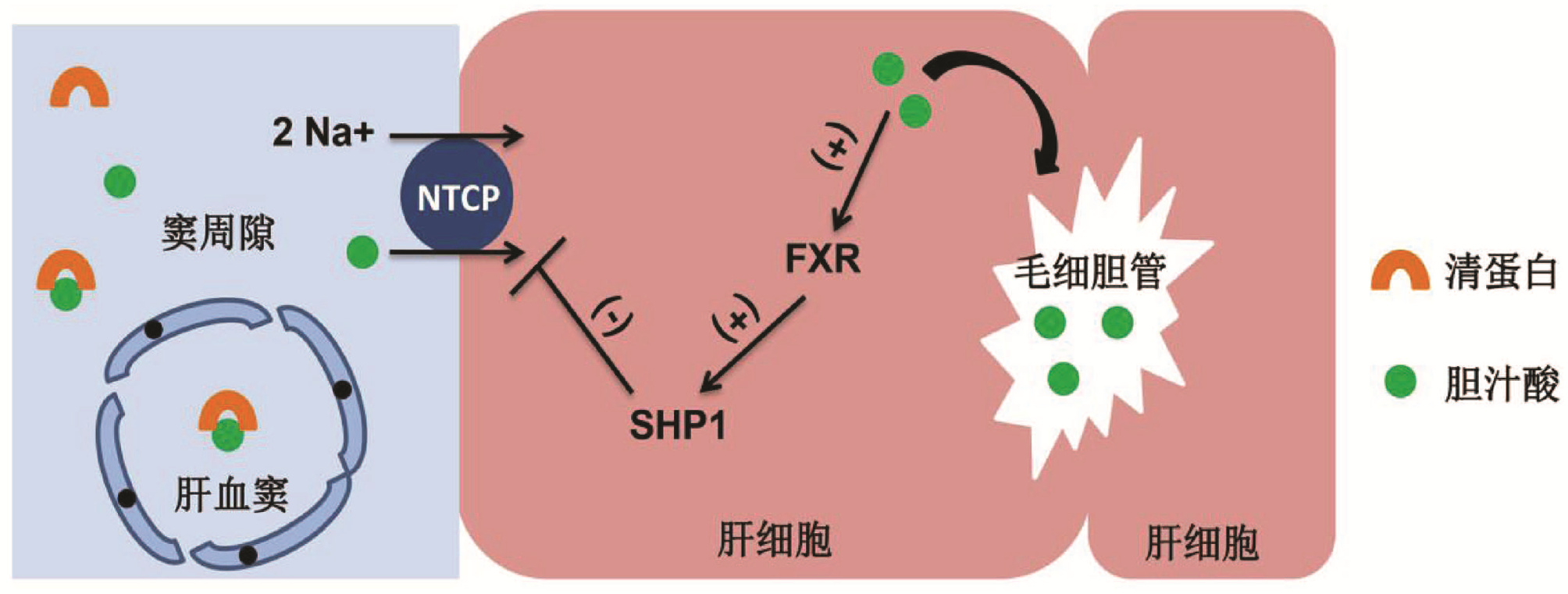钠牛磺胆酸共转运多肽在肝胆疾病中的研究进展
DOI: 10.3969/j.issn.1001-5256.2022.05.043
利益冲突声明:所有作者均声明不存在利益冲突。
作者贡献声明:高小强负责资料分析,撰写论文; 左石、贾晓东负责提出具体修改意见并进行修改; 陆荫英负责拟定撰写思路,指导文章写作并最终定稿。
Research advances in sodium taurocholate cotransporting polypeptide in hepatobiliary diseases
-
摘要: 钠牛磺胆酸共转运多肽(NTCP)既是胆汁酸吸收入肝的重要转运体,又是HBV、HDV的功能性受体; 其结构、功能、基因特点、表达调控机制等已得到广泛研究; 且NTCP与慢性病毒性肝炎、非酒精性脂肪性肝病、肝纤维化、原发性胆汁性胆管炎、肝细胞癌相关,本文系统阐述了NTCP在各种肝胆疾病中的作用,为相关疾病的诊断及治疗提供新方向。
-
关键词:
- 肝炎, 病毒性, 人 /
- 非酒精性脂肪性肝病 /
- 肝硬化 /
- 肝硬化, 胆汁性 /
- 癌, 肝细胞 /
- 钠牛磺胆酸共转运多肽
Abstract: Sodium taurocholate cotransporting polypeptide (NTCP) is not only an important transporter for bile acid absorption into the liver, but also a functional receptor for HBV and HDV, and extensive studies have been performed for its structure, function, gene characteristics, and expression and regulation mechanisms. NTCP is also associated with chronic viral hepatitis, nonalcoholic fatty liver disease, liver fibrosis, primary biliary cholangitis, and hepatocellular carcinoma. This article elaborates on the role of NTCP in various hepatobiliary diseases, so as to provide new direction for the diagnosis and treatment of related diseases. -
[1] PALATINI M, MÜLLER SF, LOWJAGA K, et al. Mutational analysis of the GXXXG/A motifs in the human Na(+)/Taurocholate co-transporting polypeptide NTCP on its bile acid transport function and hepatitis B/D virus receptor function[J]. Front Mol Biosci, 2021, 8: 699443. DOI: 10.3389/fmolb.2021.699443. [2] YAN H, ZHONG G, XU G, et al. Sodium taurocholate cotransporting polypeptide is a functional receptor for human hepatitis B and D virus[J]. Elife, 2012, 1: e00049. DOI: 10.7554/eLife.00049. [3] AGUILAR-OLIVOS NE, CARRILLO-CÓRDOVA D, ORIA-HERNÁNDEZ J, et al. The nuclear receptor FXR, but not LXR, up- regulates bile acid transporter expression in non-alcoholic fatty liver disease[J]. Ann Hepatol, 2015, 14(4): 487-493. [4] SALHAB A, AMER J, LU Y, et al. Sodium(+)/taurocholate cotransporting polypeptide as target therapy for liver fibrosis[J]. Gut, 2021. DOI: 10.1136/gutjnl-2020-323345.[Online ahead of print] [5] TAKEYAMA Y, SAKISAKA S. Hepatobiliary membrane transporters in primary biliary cirrhosis[J]. Hepatol Res, 2012, 42(2): 120-130. DOI: 10.1111/j.1872-034X.2011.00912.x. [6] BINH MT, HOAN NX, van TONG H, et al. NTCP S267F variant associates with decreased susceptibility to HBV and HDV infection and decelerated progression of related liver diseases[J]. Int J Infect Dis, 2019, 80: 147-152. DOI: 10.1016/j.ijid.2019.01.038. [7] APPELMAN MD, WETTENGEL JM, PROTZER U, et al. Molecular regulation of the hepatic bile acid uptake transporter and HBV entry receptor NTCP[J]. Biochim Biophys Acta Mol Cell Biol Lipids, 2021, 1866(8): 158960. DOI: 10.1016/j.bbalip.2021.158960. [8] WETTENGEL JM, BURWITZ BJ. Innovative HBV animal models based on the entry receptor NTCP[J]. Viruses, 2020, 12(8): 828. DOI: 10.3390/v12080828. [9] FUKANO K, OSHIMA M, TSUKUDA S, et al. NTCP oligomerization occurs downstream of the NTCP-EGFR interaction during hepatitis B virus internalization[J]. J Virol, 2021, 95(24): e0093821. DOI: 10.1128/JVI.00938-21. [10] MARENINOVA O, SHIN JM, VAGIN O, et al. Topography of the membrane domain of the liver Na+-dependent bile acid transporter[J]. Biochemistry, 2005, 44(42): 13702-13712. DOI: 10.1021/bi051291x. [11] KIM JY, KIM KH, LEE JA, et al. Transporter-mediated bile acid uptake causes Ca2+-dependent cell death in rat pancreatic acinar cells[J]. Gastroenterology, 2002, 122(7): 1941-1953. DOI: 10.1053/gast.2002.33617. [12] RUSSELL DW. Fifty years of advances in bile acid synthesis and metabolism[J]. J Lipid Res, 2009, 50 (Suppl): S120-S125. DOI: 10.1194/jlr.R800026-JLR200. [13] STIEGER B. The role of the sodium-taurocholate cotransporting polypeptide (NTCP) and of the bile salt export pump (BSEP) in physiology and pathophysiology of bile formation[J]. Handb Exp Pharmacol, 2011, 201: 205-259. DOI: 10.1007/978-3-642-14541-4_5. [14] VERRIER ER, COLPITTS CC, BACH C, et al. Solute carrier NTCP regulates innate antiviral immune responses targeting hepatitis C virus infection of hepatocytes[J]. Cell Rep, 2016, 17(5): 1357-1368. DOI: 10.1016/j.celrep.2016.09.084. [15] HO RH, LEAKE BF, ROBERTS RL, et al. Ethnicity-dependent polymorphism in Na+-taurocholate cotransporting polypeptide (SLC10A1) reveals a domain critical for bile acid substrate recognition[J]. J Biol Chem, 2004, 279(8): 7213-7222. DOI: 10.1074/jbc.M305782200. [16] SU Z, LI Y, LIAO Y, et al. Association of the gene polymorphisms in sodium taurocholate cotransporting polypeptide with the outcomes of hepatitis B infection in Chinese Han population[J]. Infect Genet Evol, 2014, 27: 77-82. DOI: 10.1016/j.meegid.2014.07.001. [17] HU HH, LIU J, LIN YL, et al. The rs2296651 (S267F) variant on NTCP (SLC10A1) is inversely associated with chronic hepatitis B and progression to cirrhosis and hepatocellular carcinoma in patients with chronic hepatitis B[J]. Gut, 2016, 65(9): 1514-1521. DOI: 10.1136/gutjnl-2015-310686. [18] YU Y, LI S, LIANG W. Bona fide receptor for hepatitis B and D viral infections: Mechanism, research models and molecular drug targets[J]. Emerg Microbes Infect, 2018, 7(1): 134. DOI: 10.1038/s41426-018-0137-7. [19] IMAI S, KIKUCHI R, KUSUHARA H, et al. Analysis of DNA methylation and histone modification profiles of liver-specific transporters[J]. Mol Pharmacol, 2009, 75(3): 568-576. DOI: 10.1124/mol.108.052589. [20] HALILBASIC E, CLAUDEL T, TRAUNER M. Bile acid transporters and regulatory nuclear receptors in the liver and beyond[J]. J Hepatol, 2013, 58(1): 155-168. DOI: 10.1016/j.jhep.2012.08.002. [21] MAYATI A, LE VEE M, MOREAU A, et al. Protein kinase C-dependent regulation of human hepatic drug transporter expression[J]. Biochem Pharmacol, 2015, 98(4): 703-717. DOI: 10.1016/j.bcp.2015.10.007. [22] SARGIACOMO C, EL-KEHDY H, POURCHER G, et al. Age-dependent glycosylation of the sodium taurocholate cotransporter polypeptide: From fetal to adult human livers[J]. Hepatol Commun, 2018, 2(6): 693-702. DOI: 10.1002/hep4.1174. [23] FERRELL JM, CHIANG J. Understanding bile acid signaling in diabetes: From pathophysiology to therapeutic targets[J]. Diabetes Metab J, 2019, 43(3): 257-272. DOI: 10.4093/dmj.2019.0043. [24] YAN H, PENG B, LIU Y, et al. Viral entry of hepatitis B and D viruses and bile salts transportation share common molecular determinants on sodium taurocholate cotransporting polypeptide[J]. J Virol, 2014, 88(6): 3273-3284. DOI: 10.1128/JVI.03478-13. [25] GLEBE D, GOLDMANN N, LAUBER C, et al. HBV evolution and genetic variability: Impact on prevention, treatment and development of antivirals[J]. Antiviral Res, 2021, 186: 104973. DOI: 10.1016/j.antiviral.2020.104973. [26] PIERRA ROUVIERE C, DOUSSON CB, TAVIS JE. HBV replication inhibitors[J]. Antiviral Res, 2020, 179: 104815. DOI: 10.1016/j.antiviral.2020.104815. [27] LIU Y, RUAN H, LI Y, et al. Potent and specific inhibition of NTCP-Mediated HBV/HDV infection and substrate transporting by a novel, oral-available cyclosporine a analogue[J]. J Med Chem, 2021, 64(1): 543-565. DOI: 10.1021/acs.jmedchem.0c01484. [28] DONKERS JM, APPELMAN MD, VAN DE GRAAF S. Mechanistic insights into the inhibition of NTCP by myrcludex B[J]. JHEP Rep, 2019, 1(4): 278-285. DOI: 10.1016/j.jhepr.2019.07.006. [29] FUKANO K, TSUKUDA S, WATASHI K, et al. Concept of viral inhibitors via NTCP[J]. Semin Liver Dis, 2019, 39(1): 78-85. DOI: 10.1055/s-0038-1676804. [30] HUANG DQ, EL-SERAG HB, LOOMBA R. Global epidemiology of NAFLD-related HCC: Trends, predictions, risk factors and prevention[J]. Nat Rev Gastroenterol Hepatol, 2021, 18(4): 223-238. DOI: 10.1038/s41575-020-00381-6. [31] HARRISON SA, NEFF G, GUY CD, et al. Efficacy and safety of aldafermin, an engineered FGF19 analog, in a randomized, double-blind, placebo-controlled trial of patients with nonalcoholic steatohepatitis[J]. Gastroenterology, 2021, 160(1): 219-231. e1. DOI: 10.1053/j.gastro.2020.08.004. [32] BECHMANN LP, KOCABAYOGLU P, SOWA JP, et al. Free fatty acids repress small heterodimer partner (SHP) activation and adiponectin counteracts bile acid-induced liver injury in superobese patients with nonalcoholic steatohepatitis[J]. Hepatology, 2013, 57(4): 1394-1406. DOI: 10.1002/hep.26225. [33] FERSLEW BC, XIE G, JOHNSTON CK, et al. Altered bile acid metabolome in patients with nonalcoholic steatohepatitis[J]. Dig Dis Sci, 2015, 60(11): 3318-3328. DOI: 10.1007/s10620-015-3776-8. [34] CHO EJ, YOON JH, KWAK MS, et al. Tauroursodeoxycholic acid attenuates progression of steatohepatitis in mice fed a methionine-choline-deficient diet[J]. Dig Dis Sci, 2014, 59(7): 1461-1474. DOI: 10.1007/s10620-014-3217-0. [35] KISSELEVA T, BRENNER D. Molecular and cellular mechanisms of liver fibrosis and its regression[J]. Nat Rev Gastroenterol Hepatol, 2021, 18(3): 151-166. DOI: 10.1038/s41575-020-00372-7. [36] SVEGLIATI-BARONI G, RIDOLFI F, HANNIVOORT R, et al. Bile acids induce hepatic stellate cell proliferation via activation of the epidermal growth factor receptor[J]. Gastroenterology, 2005, 128(4): 1042-1055. DOI: 10.1053/j.gastro.2005.01.007. [37] TANAKA A. Current understanding of primary biliary cholangitis[J]. Clin Mol Hepatol, 2021, 27(1): 1-21. DOI: 10.3350/cmh.2020.0028. [38] KOJIMA H, NIES AT, KÖNIG J, et al. Changes in the expression and localization of hepatocellular transporters and radixin in primary biliary cirrhosis[J]. J Hepatol, 2003, 39(5): 693-702. DOI: 10.1016/s0168-8278(03)00410-0. [39] HONDA A, IKEGAMI T, NAKAMUTA M, et al. Anticholestatic effects of bezafibrate in patients with primary biliary cirrhosis treated with ursodeoxycholic acid[J]. Hepatology, 2013, 57(5): 1931-1941. DOI: 10.1002/hep.26018. [40] MING J, XU Q, GAO L, et al. Kinsenoside alleviates 17α-ethinylestradiol-induced cholestatic liver injury in rats by inhibiting inflammatory responses and regulating FXR-mediated bile acid homeostasis[J]. Pharmaceuticals (Basel), 2021, 14(5): 452. DOI: 10.3390/ph14050452. [41] LOOSEN SH, CASTOLDI M, JÖRDENS MS, et al. Serum levels of circulating microRNA-107 are elevated in patients with early-stage HCC[J]. PLoS One, 2021, 16(3): e0247917. DOI: 10.1371/journal.pone.0247917. [42] ZOLLNER G, WAGNER M, FICKERT P, et al. Hepatobiliary transporter expression in human hepatocellular carcinoma[J]. Liver Int, 2005, 25(2): 367-379. DOI: 10.1111/j.1478-3231.2005.01033.x. [43] KANG J, WANG J, CHENG J, et al. Down-regulation of NTCP expression by cyclin D1 in hepatitis B virus-related hepatocellular carcinoma has clinical significance[J]. Oncotarget, 2017, 8(34): 56041-56050. DOI: 10.18632/oncotarget.10241. [44] JING YY, LIU WT, GUO SW, et al. Hepatitis B virus (HBV) receptors: Deficiency in tumor results in scant HBV infection and overexpression in peritumor leads to higher recurrence risk[J]. Oncotarget, 2015, 6(40): 42952-42962. DOI: 10.18632/oncotarget.5518. [45] JANG ES, YOON JH, LEE SH, et al. Sodium taurocholate cotransporting polypeptide mediates dual actions of deoxycholic acid in human hepatocellular carcinoma cells: enhanced apoptosis versus growth stimulation[J]. J Cancer Res Clin Oncol, 2014, 140(1): 133-144. DOI: 10.1007/s00432-013-1554-6. -



 PDF下载 ( 2054 KB)
PDF下载 ( 2054 KB)


 下载:
下载:


